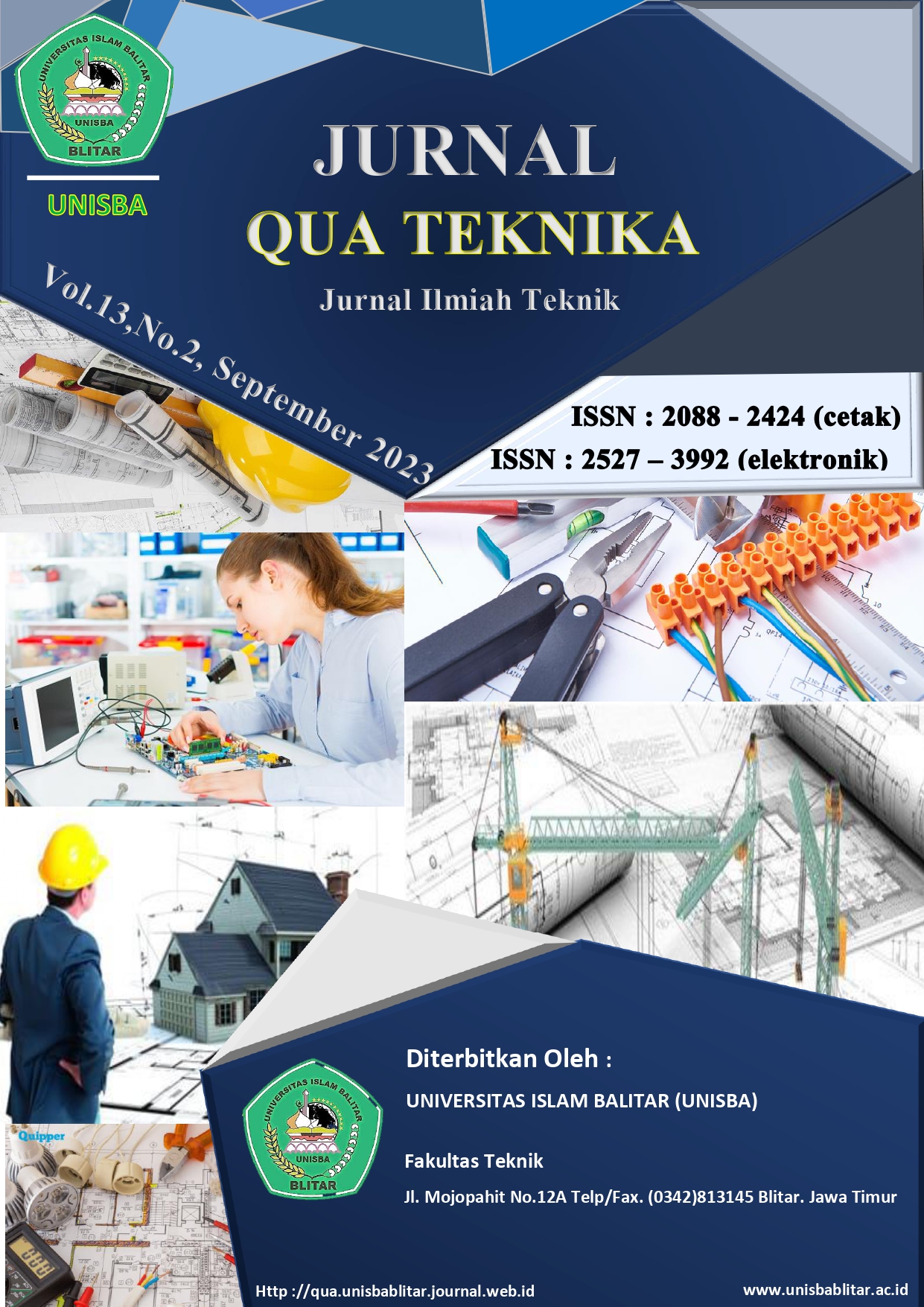PENGARUH SUBSTITUSI CANGKANG KERANG DARI ENDE NTT TERHADAP KUAT TEKAN DANKUAT LENTUR BETON fc’= 19,3 MPa
DOI:
https://doi.org/10.35457/quateknika.v13i2.3155Keywords:
Clamor shell variation (%),, Concrete quality fc' = 19.3 Mpa,, Compressive Strength and Flexural Strength.Abstract
The use of concrete for basic construction materials today is indeed increasing rapidly along with the development of construction construction.Only a concrete quality of 19.3 MPa (fc '= 25 MPa) was considered in this study. Since cement, aggregates, sand and water are extracted from nature, they must be limited. So in this study using additional material clam shells. One of them is shells, shellfish waste or shells are usually only used as decorations or toys so that there is still a lot of waste wasted. Inside the shell, the clam contains pozzolan chemical compounds, namely lime (CaO), aluminum oxide and silica. It can be expected to improve the quality of concrete.
As a result of compressive strength test by changing the clamshell to 0%, 10%, 20%, 30%, 40% and 50%, the average compressive strength value of 0% (ordinary concrete) was 15.81 MPa. The addition of a 10% clam shell results in an average compressive strength value of 20.58 MPa. For the addition of clam shells by 20% obtained an average compressive strength value of 23.37 MPa. 30% yields an average compressive strength of 40.31 Mpa, to 40% of 29.12 Mpa. As for the addition of 50% clam shells, the average compressive strength value is 24.79 Mpa. Thus it can be concluded that the addition of clam shells 30% compressive strength value is higher than the compressive strength value of concrete with the addition of clam shells 0%, 10%, 20%, 40%, and 50%The flexural strength test value in terms of the maximum average moment on the beam for each variation of the test specimen is maximum moment value 75.02 kN.m for 0% variation, maximum moment value 62.52 kN.m for 10% variation, maximum moment value 68.77 kN.m for 20% variation, maximum moment value for 30% variation 62.52 kN.m, 40% variation at maximum moment value of 62.52 kN.m. Therefore, the percentage of specimens that can withstand the highest load in the flexural strength test is 0% and the maximum moment value is 75.02 kN.m.
References
Badan Standarisasi Nasional Indonesia, “SNI 2847:2013 Persyaratan Beton Struktural untuk Bangunan Gedung,” Bsn, p. 265, 2013.
BSN, “SNI 7064:2014 Semen Portland Komposit,” Badan Stand. Nas., pp. 1–128, 2014.
W. M. Lolo, A. Karjanto, and D. Ningrum, “Uji Kuat Tekan dan Uji Kuat Tarik Beton Dengan Agregat Kasar dan Halus dari Sumba Barat Daya pada Mutu Beton= 19, 3 MPa,” Pros. SENTIKUIN (Seminar …, vol. 2, pp. 1–7, 2019.
BSN, “SNI 1970:2008 Cara Uji Berat Jenis dan Penyerapan Air Agregat Halus,” Badan Standar Nas. Indones., pp. 7–18, 2008.
SNI 2493-2011, “Tata Cara Pembuatan dan Perawatan Benda Uji Beton di Laboratorium,” Badan Standar Nas. Indones., p. 23, 2011, [Online]. Available: www.bsn.go.id
R. Imani, N. Yanto, and M. Susiwa, “Pengaruh Penambahan Abu Cangkang Kerang Darah (Anadara Granosa) sebagai Agregat Halus terhadap Kuat Tekan Beton,” Maj. Ilm. UPI YPTK, vol. 26, no. 1, pp. 14–23, 2019.
Ameliana, Ghitarina, and I. Suryana, “Analisis Kandungan Pb, Cd, dan Cu pada Berbagai Ukuran Kerang Darah (Anadara granosa) di Muara Pantuan Kecamatan Anggana Kabupaten Kutai Kartanegara,” Aquarine, vol. 5, no. 2, pp. 22–29, 2018.
Vitalis, E. Samsurizal, and A. Supriyad, “Pengaruh Tambahan Cangkang Kerang Terhadap Kuat Beton,” J. PWK, Laut, Sipil, Tambang, vol. 2, no. 2, pp. 1–9, 2017.
A. Junaidi, “Daur Ulang Limbah Pecahan Beton Sebagai Pengganti Agregat Kasar Pada Campuran Beton,” Daur Ulang Limbah Pecahan Bet. Sebagai Pengganti Agreg. Kasar Pada Campuran Bet., vol. 4, no. 1, pp. 5–15, 2015.
F. P. Pane, H. Tanudjaja, and R.S. Windah, “Pengujian Kuat Tarik Belah Dengan Variasi Kuat Tekan Beton,” J. Sipil Statik, vol. 3, no. 5, pp. 313–321, 2015.
S. N. Indonesia, “Cara Uji Kuat Tekan Beton dengan Benda Uji Silinder,” Badan Standarisasi Nasional, Jakarta, 1974.
Downloads
Published
Issue
Section
License
Authors who publish with this journal agree to the following terms:
- Copyright on any article is retained by the author(s).
- Author grant the journal, right of first publication with the work simultaneously licensed under a Creative Commons Attribution License that allows others to share the work with an acknowledgement of the work’s authorship and initial publication in this journal.
- Authors are able to enter into separate, additional contractual arrangements for the non-exclusive distribution of the journal’s published version of the work (e.g., post it to an institutional repository or publish it in a book), with an acknowledgement of its initial publication in this journal.
- Authors are permitted and encouraged to post their work online (e.g., in institutional repositories or on their website) prior to and during the submission process, as it can lead to productive exchanges, as well as earlier and greater citation of published work.
- The article and any associated published material is distributed under the Creative Commons Attribution-ShareAlike 4.0 International License
Deprecated: json_decode(): Passing null to parameter #1 ($json) of type string is deprecated in /home/ejournal.unisbablitar.ac.id/public_html/plugins/generic/citations/CitationsPlugin.php on line 68










